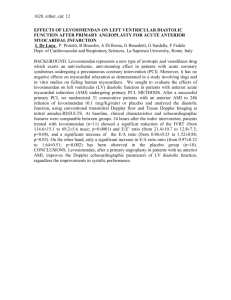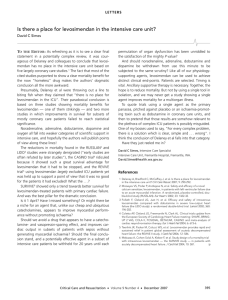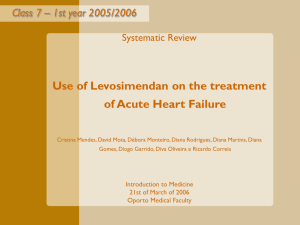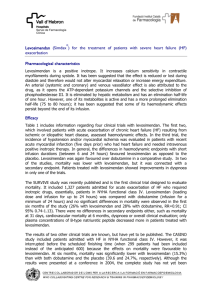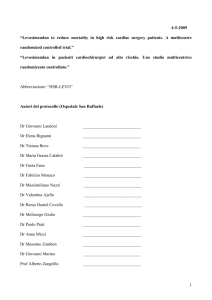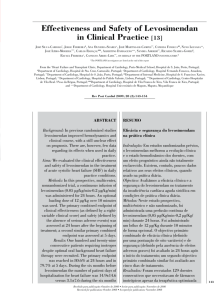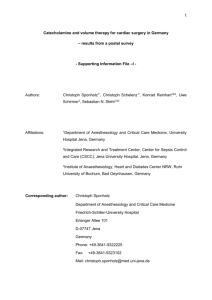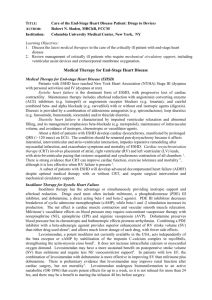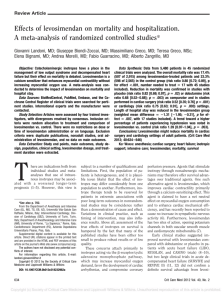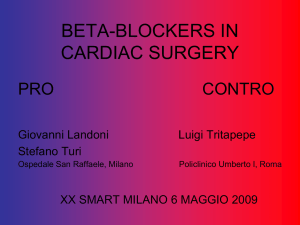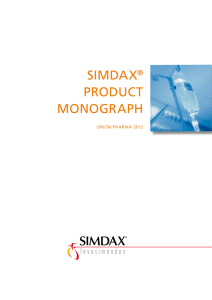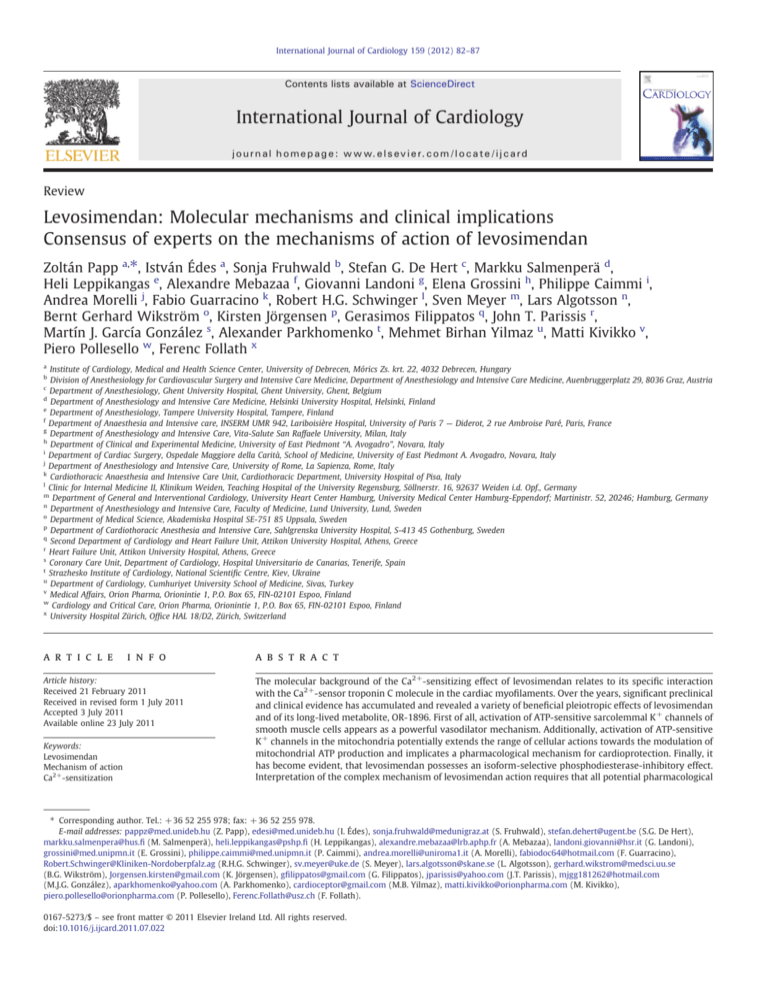
International Journal of Cardiology 159 (2012) 82–87
Contents lists available at ScienceDirect
International Journal of Cardiology
j o u r n a l h o m e p a g e : w w w. e l s ev i e r. c o m / l o c a t e / i j c a r d
Review
Levosimendan: Molecular mechanisms and clinical implications
Consensus of experts on the mechanisms of action of levosimendan
Zoltán Papp a,⁎, István Édes a, Sonja Fruhwald b, Stefan G. De Hert c, Markku Salmenperä d,
Heli Leppikangas e, Alexandre Mebazaa f, Giovanni Landoni g, Elena Grossini h, Philippe Caimmi i,
Andrea Morelli j, Fabio Guarracino k, Robert H.G. Schwinger l, Sven Meyer m, Lars Algotsson n,
Bernt Gerhard Wikström o, Kirsten Jörgensen p, Gerasimos Filippatos q, John T. Parissis r,
Martín J. García González s, Alexander Parkhomenko t, Mehmet Birhan Yilmaz u, Matti Kivikko v,
Piero Pollesello w, Ferenc Follath x
a
Institute of Cardiology, Medical and Health Science Center, University of Debrecen, Mórics Zs. krt. 22, 4032 Debrecen, Hungary
Division of Anesthesiology for Cardiovascular Surgery and Intensive Care Medicine, Department of Anesthesiology and Intensive Care Medicine, Auenbruggerplatz 29, 8036 Graz, Austria
Department of Anesthesiology, Ghent University Hospital, Ghent University, Ghent, Belgium
d
Department of Anesthesiology and Intensive Care Medicine, Helsinki University Hospital, Helsinki, Finland
e
Department of Anesthesiology, Tampere University Hospital, Tampere, Finland
f
Department of Anaesthesia and Intensive care, INSERM UMR 942, Lariboisière Hospital, University of Paris 7 — Diderot, 2 rue Ambroise Paré, Paris, France
g
Department of Anesthesiology and Intensive Care, Vita-Salute San Raffaele University, Milan, Italy
h
Department of Clinical and Experimental Medicine, University of East Piedmont “A. Avogadro”, Novara, Italy
i
Department of Cardiac Surgery, Ospedale Maggiore della Carità, School of Medicine, University of East Piedmont A. Avogadro, Novara, Italy
j
Department of Anesthesiology and Intensive Care, University of Rome, La Sapienza, Rome, Italy
k
Cardiothoracic Anaesthesia and Intensive Care Unit, Cardiothoracic Department, University Hospital of Pisa, Italy
l
Clinic for Internal Medicine II, Klinikum Weiden, Teaching Hospital of the University Regensburg, Söllnerstr. 16, 92637 Weiden i.d. Opf., Germany
m
Department of General and Interventional Cardiology, University Heart Center Hamburg, University Medical Center Hamburg-Eppendorf; Martinistr. 52, 20246; Hamburg, Germany
n
Department of Anesthesiology and Intensive Care, Faculty of Medicine, Lund University, Lund, Sweden
o
Department of Medical Science, Akademiska Hospital SE-751 85 Uppsala, Sweden
p
Department of Cardiothoracic Anesthesia and Intensive Care, Sahlgrenska University Hospital, S-413 45 Gothenburg, Sweden
q
Second Department of Cardiology and Heart Failure Unit, Attikon University Hospital, Athens, Greece
r
Heart Failure Unit, Attikon University Hospital, Athens, Greece
s
Coronary Care Unit, Department of Cardiology, Hospital Universitario de Canarias, Tenerife, Spain
t
Strazhesko Institute of Cardiology, National Scientific Centre, Kiev, Ukraine
u
Department of Cardiology, Cumhuriyet University School of Medicine, Sivas, Turkey
v
Medical Affairs, Orion Pharma, Orionintie 1, P.O. Box 65, FIN-02101 Espoo, Finland
w
Cardiology and Critical Care, Orion Pharma, Orionintie 1, P.O. Box 65, FIN-02101 Espoo, Finland
x
University Hospital Zürich, Office HAL 18/D2, Zürich, Switzerland
b
c
a r t i c l e
i n f o
Article history:
Received 21 February 2011
Received in revised form 1 July 2011
Accepted 3 July 2011
Available online 23 July 2011
Keywords:
Levosimendan
Mechanism of action
Ca2+-sensitization
a b s t r a c t
The molecular background of the Ca 2+-sensitizing effect of levosimendan relates to its specific interaction
with the Ca2+-sensor troponin C molecule in the cardiac myofilaments. Over the years, significant preclinical
and clinical evidence has accumulated and revealed a variety of beneficial pleiotropic effects of levosimendan
and of its long-lived metabolite, OR-1896. First of all, activation of ATP-sensitive sarcolemmal K+ channels of
smooth muscle cells appears as a powerful vasodilator mechanism. Additionally, activation of ATP-sensitive
K+ channels in the mitochondria potentially extends the range of cellular actions towards the modulation of
mitochondrial ATP production and implicates a pharmacological mechanism for cardioprotection. Finally, it
has become evident, that levosimendan possesses an isoform-selective phosphodiesterase-inhibitory effect.
Interpretation of the complex mechanism of levosimendan action requires that all potential pharmacological
⁎ Corresponding author. Tel.: + 36 52 255 978; fax: + 36 52 255 978.
E-mail addresses: pappz@med.unideb.hu (Z. Papp), edesi@med.unideb.hu (I. Édes), sonja.fruhwald@medunigraz.at (S. Fruhwald), stefan.dehert@ugent.be (S.G. De Hert),
markku.salmenpera@hus.fi (M. Salmenperä), heli.leppikangas@pshp.fi (H. Leppikangas), alexandre.mebazaa@lrb.aphp.fr (A. Mebazaa), landoni.giovanni@hsr.it (G. Landoni),
grossini@med.unipmn.it (E. Grossini), philippe.caimmi@med.unipmn.it (P. Caimmi), andrea.morelli@uniroma1.it (A. Morelli), fabiodoc64@hotmail.com (F. Guarracino),
Robert.Schwinger@Kliniken-Nordoberpfalz.ag (R.H.G. Schwinger), sv.meyer@uke.de (S. Meyer), lars.algotsson@skane.se (L. Algotsson), gerhard.wikstrom@medsci.uu.se
(B.G. Wikström), Jorgensen.kirsten@gmail.com (K. Jörgensen), gfilippatos@gmail.com (G. Filippatos), jparissis@yahoo.com (J.T. Parissis), mjgg181262@hotmail.com
(M.J.G. González), aparkhomenko@yahoo.com (A. Parkhomenko), cardioceptor@gmail.com (M.B. Yilmaz), matti.kivikko@orionpharma.com (M. Kivikko),
piero.pollesello@orionpharma.com (P. Pollesello), Ferenc.Follath@usz.ch (F. Follath).
0167-5273/$ – see front matter © 2011 Elsevier Ireland Ltd. All rights reserved.
doi:10.1016/j.ijcard.2011.07.022
Z. Papp et al. / International Journal of Cardiology 159 (2012) 82–87
83
interactions are analyzed carefully in the framework of the currently available evidence. These data indicate
that the cardiovascular effects of levosimendan are exerted via more than an isolated drug–receptor
interaction, and involve favorable energetic and neurohormonal changes that are unique in comparison to
other types of inodilators.
© 2011 Elsevier Ireland Ltd. All rights reserved.
Positive inotropy
Vasodilation
Cardioprotection
1. Introduction
Troponins of cardiac thin myofilaments are central in the regulation
of the contractile process. Cardiac troponin C (cTNC), one of the 3
troponin subunits, acts as a Ca2+-operated molecular switch, turning
myocardial force production on and off during cardiac systoles and
diastoles. Consequently, the kinetics and the extent of systolic
contraction and diastolic relaxation are both coordinated by the
Ca2+-binding characteristics of cTnC. For example, the increase in the
amplitude of the intracellular Ca 2+ transient – in response to the
activation of the β-adrenergic – cAMP – protein kinase A signaling
pathway – augments force production through an increase in the Ca2+
saturation of cTnC. This manner of myocardial force augmentation is
associated with a significant increase in myocardial oxygen demand,
which is a limit to the pharmacological utilization of the β-adrenergic
signaling pathway in the diseased heart. Therefore, during the past years
intense pharmacological research has evolved to circumvent the
seemingly tight connection between myocardial positive inotropy and
myocardial oxygen wastage [1,2] in the hope that fine tuning of
myofilament Ca2+-responsiveness (e.g. by Ca2+-sensitizers, direct
myosin activators) [1] and/or of intracellular Ca 2+-cycling (e.g.
sarcoplasmic reticulum Ca2+-pump (SERCA) gene transfer) [2] will
promote myocardial contractility in a clinically desirable way.
Levosimendan (the (−) enantiomer of {[4-(1,4,5,6-tetrahydro-4methyl-6-oxo-3-pyridazinyl)phenyl]hydrazono}propanedinitrile), a
myofilament Ca 2+-sensitizer positive inotropic drug with vasodilator
properties was introduced for the treatment of acute heart failure more
than a decade ago. During the subsequent years the base of data
accumulated for levosimendan has come to exceed that for any other
positive inotropic drug in routine clinical use. The initial optimism,
fueled by the promising improvement in short-term outcome of early
clinical trials in patients with decompensated heart failure (LIDO) or
developing heart failure acute myocardial infarction (RUSSLAN) [3,4],
has been tempered by less favorable impact on long-term outcome in
the large-scale clinical trials SURVIVE and REVIVE [5]. Nevertheless, the
results of recent meta-analyses [6–8] offer encouraging perspectives on
the usefulness of levosimendan in circumstances of acute heart failure.
The mechanism of action of levosimendan is complex as it
involves: 1) an active long-lived metabolite, OR-1896 (the (−)
enantiomer of N-[4-(1,4,5,6-tetrahydro-4-methyl-6-oxo-3-pyridazinyl)
phenyl] acetamide), and 2) interactions with more than one molecular
target within the cardiovascular system (Table 1, Fig. 1). This multiplicity
of effects has been variably simplified as an advantageous or
disadvantageous feature of levosimendan. One has therefore to consider
all interactions and weigh their relative significance carefully when
evaluating levosimendan-induced cardiovascular effects in the context
of patient selection, timing, dosing and combination therapy [9].
This document has been developed from a consensus reached by
experts on the clinically significant actions of levosimendan and is
intended to serve as a reference when positioning levosimendan
among the currently available drugs for the management of acute
heart failure. To this end, we provide a brief overview on the
mechanisms of action of levosimendan with direct clinical relevance,
and attempt to dispel the accumulated ambiguity in respect of its
cardiovascular effects.
2. Levosimendan and its active metabolite OR-1896
During the metabolism of levosimendan approximately 5% of the
drug is converted to the metabolite OR-1855 (the (−) enantiomer of
4-(1,4,5,6-tetrahydro-4-methyl-6-oxo-3-pyridazinyl)phenylamine)
in the large intestine, and then acetylated in the liver to form the
active metabolite OR-1896. Binding to plasma proteins is 98% for
levosimendan but only 40% for OR-1896: this explains why a
relatively low total plasma level of the metabolite may evoke clinically
significant effects [10]. Unlike levosimendan, which has an elimination half-life of 1–1.5 h, the half-life of OR-1896 is about 75 to 80 h
allowing cardiovascular effects to persist up to 7 to 9 days after
discontinuation of a 24-hour infusion of levosimendan [11]. The
pharmacokinetic of the parent drug is unaltered in subjects with
severe renal impairment or with moderate hepatic impairment,
whereas the elimination of its metabolites can be prolonged [12].
3. Ca 2+-sensitization
Levosimendan interacts with the Ca 2+-saturated cTnC and this
forms the basis of its Ca 2+-sensitizing mechanism [13]. The binding
site for levosimendan on cTnC has been localized to a hydrophobic
region of its N-domain near the so-called D/E linker region [14,15].
There are important hydrogen-bond donor and acceptor groups on
Table 1
The three major mechanisms of levosimendan.
Cellular
target
Subcellular
target
Molecular
target
Positive inotropy Vasodilation
Cardioprotection
Cardiomyocytes
Cardiomyocytes
Myofilaments
Vascular smooth
muscle cells
Sarcolemma
Mithochondria
ATP-sensitive
ATP-sensitive K+-channels
Calcium
saturated form of K+-channels
troponin C
Molecular
Calcium
Hyperpolarization Protection of mitochondria
mechanism sensitization
in ischemia-reperfusion
Fig. 1. The cardiovascular effects of levosimendan and of its active metabolite, OR-1896
develop in response to a set of concerted pharmacological actions having multiple
interactions with each other. The inodilator effects of levosimendan are best explained
by direct drug-target interactions with cTnC molecules in the myofilaments of the
cardiomyocytes and with vascular K+ channels, while cardioprotection emerges as the
end-result of mitochondrial ATP-sensitive K+ channel opening, energy sparing and
neurohumoral modulation.
84
Z. Papp et al. / International Journal of Cardiology 159 (2012) 82–87
the pyridazinone ring and on the mesoxalonitrile–hydrazone moieties
of levosimendan that bind to cTnC. Hence, it is likely that these groups
form hydrogen bonds with polar or charged amino acids in the
hydrophobic pocket of the Ca 2+-saturated N-terminal domain of
cTnC. The consequence of levosimendan binding is that the
Ca 2+-saturated cTnC is stabilized in the presence of the drug [14].
The scheme that was put forward on the basis of this conformational
change involves a prolonged interaction between cTnC and cardiac
troponin I, thereby promoting contractile force in the presence of
levosimendan without an increase in the amplitude of intracellular
Ca 2+ transient. The magnitude of Ca 2+-sensitization evoked by
levosimendan or OR-1896 appeared to be less than the maximal
effect of other known Ca 2+-sensitizers, although similar to what
expected from length-dependent Ca 2+-sensitization during the
activation of the Frank–Starling mechanism [16,17]. Diastolic function
is not impaired by levosimendan [18–20] potentially because of the
mild degree of Ca 2+-sensitization, and probably also because
dissociation of Ca 2+ from the cTnC molecule at the diastolic level of
intracellular Ca 2+ precludes its interaction with levosimendan [21].
The active metabolite OR-1896 exhibits comparable hemodynamic
effects to those of levosimendan via Ca 2+-sensitization [22–24]:
similar interactions between OR-1896 and cTnC can therefore be
postulated. However, structural biochemical data for the interaction
between OR-1896 and cTnC are not yet available.
4. Vasodilation
Levosimendan and OR-1896 evoke prominent vasodilatory responses
[25–27]. Levosimendan has the potential to open ATP-sensitive K+
channels [28], and consequent hyperpolarization of vascular smooth
muscle cells has been suggested to explain the drug's vasodilatory effects.
In line with this proposal, inhibitors of ATP-sensitive K + channels
mitigate vasodilatation induced by levosimendan or OR-1896, although
these pharmacological approaches also suggested that other types of K+
channels (e.g. Ca2+-activated K + channels and voltage-gated K +
channels) might be also involved [26,27,29,30]. The composition of
K + channels mediating vasodilatory responses may depend on vessel
type and also on vascular diameter. Interestingly, recent experimental
data indicated an endothelial component for the levosimendan-induced
vasodilation, and interactions between ATP-sensitive K + channel
activation and NO production [31]. Vasodilation during levosimendan
administration has been demonstrated at the arterial sides of the
pulmonary [30], coronary [25,29,32] and peripheral circulations [26],
and at the venous sides of the portal and saphenous systems [27].
profoundly in the regulation of the intracellular cyclic nucleotides as
well as in intracellular Ca2+ concentration [43–45], and hence the
consequence of an isolated inhibition of PDE III might vary. What can be
anticipated is that the chance of levosimendan causing an increase in
intracellular cAMP is the least at low doses where, without doubts other
PDE isoforms (e.g. PDE IV) can substitute for PDE III.
6. Neurohormones, cytokines and biomarkers
In heart failure a direct relationship exists between mortality and
brain natriuretic peptide (BNP) production [46,47], and levosimendan
evokes a robust decrease in circulating BNP levels [5,48–50].
Neurohumoral alterations seen following levosimendan administrations are interesting because an increasing number of enzymes,
hormones, biologic substances, and other markers of cardiac stress
and malfunction, as well as myocyte injury – collectively referred to as
biomarkers – are widely regarded as being relevant to the pathogenesis and progression of chronic heart failure. Moreover, reduced levels
of potentially ominous biomarkers are increasingly considered as
surrogate end-points in several recent clinical investigations. It is
therefore a matter of note that reductions in pro-inflammatory
cytokines [48,51,52], favorable effects on oxidative and nitrosative
stress markers [49] and prevention of cardiomyocyte apoptosis [52]
have been all reported in heart failure patients in response to
levosimendan infusions. Moreover, the magnitude of the treatmentassociated BNP reduction following levosimendan therapy in acutely
decompensated heart failure patients correlates positively with
improvements in clinical outcome at 6 months [53]. Hence, patients
with more pronounced BNP reductions appear benefit more from
levosimendan administrations than those with less pronounced BNP
reductions. Although the molecular mechanisms by which the
above-mentioned levosimendan-evoked neurohumoral alterations
develop are not entirely understood, several cellular processes
ranging from the preservation of endothelial function [54] to the
inhibition of platelet aggregation [55] have been proposed. Collectively, these neurohumoral alterations suggest an immunmodulatory
profile for levosimendan, and hint that besides its well-characterized
pharmacological targets, the drug may mobilize several, possibly
indirect, cardioprotective mechanisms. The inotropic and vasodilatory
effects of levosimendan are thus complemented in potentially
favourable ways by changes in the neurohormone profile and tissue
oxidation status in patients with advanced heart failure [56].
5. Phosphodiesterase inhibition
7. Energetic considerations
Both levosimendan and OR-1896 are highly selective inhibitors of
the phosphodiesterase (PDE) III isoform. An interaction between
levosimendan-evoked positive inotropy or lusitropy and cAMP
signaling has been suggested from some experimental studies [33–
36]. However, it is recognized that an increase in intracellular cAMP
concentration through PDE-inhibition depends on a complex interplay
among the available PDE isoforms, their subcellular localization and
parallel signaling cascades [37,38], and it is clearly demonstrated that
neither levosimendan nor its active metabolite affect the function of
other PDE isozymes at their therapeutic concentrations [22]. Thus,
higher than therapeutic concentrations of levosimendan and speciesdependent characteristics of cyclic nucleotide signaling may potentially
explain the experimentally observed interaction between cAMP
signaling and positive inotropy/lusitropy, since results of several
investigations indicate that alterations in intracellular Ca 2+ concentration (resulting from cAMP elevation secondary to PDE inhibition) are
not a prerequisite for the cardiac effects of levosimendan [39–42].
However, it is also to be acknowledged that cardiomyocytes of patients
at various different stages of their cardiovascular diseases may differ
When the effects on cardiovascular energy balance are addressed all
the myocardial and systemic effects of levosimendan and of its
metabolite have to be taken into account including positive inotropy,
peripheral and coronary vasodilation, potential mitochondrial effects
and parallel neurohumoral alterations [57]. In short, a Ca 2+-sensitizing
mechanism at the level of the cardiomyocytes is energetically
advantageous, because in the absence of augmented Ca 2+ transients
no extra energy requirement is imposed on cardiomyocytes [58].
Indeed, the observation of a leftward shift of pressure-volume loops
obtained in instrumented dogs supports an energy-sparing effect of
levosimendan administrations [59], although part of the hemodynamic
benefit was related to cardiac unloading due to vasodilation [58,60].
Clinical data evaluating the effects of levosimendan on cardiovascular
energetics in patients suggested either neutral impact on left ventricular
efficiency and O2 consumption [61,62], or decreased myocardial oxygen
extraction and improved myocardial efficiency. Altogether, the effects of
levosimendan on cardiovascular energy requirements are reassuring,
particularly when levosimendan is compared with other positive
inotropes [57].
Z. Papp et al. / International Journal of Cardiology 159 (2012) 82–87
8. Cardioprotection
Levosimendan administration is associated with a reduction in
preload and afterload [63] and an increase in coronary blood flow [61],
plus an energetically favorable type of increase in myocardial
contractility [59]. Improved myocardial tissue perfusion might
contribute to a cardioprotective effect of levosimendan. In addition,
experimental studies have produced evidence that the levosimendan-evoked reduction in infarct size (anti-ischemic effect) may be
complemented by the opening of cardiac mitochondrial ATP-sensitive
K + channels [64,65]. The latter mechanism is particularly interesting
because agonists of mitochondrial ATP-sensitive K + channels appear
to confer protection against a variety of potentially lethal stressful
conditions [66]. Short-term cardioprotection by levosimendan have
been verified by a large number of clinical investigations [67–74], where
the effects resembled those observed in experiments mimicking
myocardial pre- or postconditioning [75–78] and/or myocardial stunning
[79–81]. Longer-term cardioprotection has been also intimated by
preclinical studies where levosimendan and/or OR-1896 mitigated
cardiomyocyte apoptosis, cardiac remodeling and myocardial inflammation [82–86]. Finally, the protective effect of levosimendan is not
restricted to the heart: experimental and clinical reports indicate positive
circulatory effects in the brain, lungs, kidneys, liver, mesenteries and
gastric mucosa [87–91].
9. Clinical implications
According to recent cardiology guidelines the application of
inotropic agents may be considered in heart failure patients with
low systolic blood pressure or low measured cardiac index in the
presence of signs of hypoperfusion or congestion, whereas vasodilators are recommended at an early stage for acute heart failure patients
without symptomatic hypotension (SBP b90 mm Hg) or serious
obstructive valvular disease. For levosimendan, a Class IIa recommendation at level of evidence B has been formulated [92]. While this
grade is not inferior in respect to other available positive inotropic
agents, the application of levosimendan offers benefits not seen
with these other types of treatments. For example, myocardial injury,
ischemia and increased occurrence of arrhythmias can all arise
as complications of β-adrenergic agonists or PDE-inhibitors; an
increased level of neurohormonal activation and renal function
worsening may accompany the application of diuretics; and the
efficacy of β-adrenergic agonists can be greatly attenuated by
β-blocker therapy. In contrast, the effects of levosimendan from the
viewpoints of cardiac energy demand, neurohumoral activation and
renal function proved either to be neutral or beneficial. Moreover,
β-blocker therapy does not limit the applicability of levosimendan, but
rather appears to augment it [3,93].
The question remains, however, why some clinical trials of
levosimendan produced statistically significant evidence of survival
benefit [3,4,94] while others did not reach significance or were neutral
[5,95]. Possible influences on this discrepancy might include the
heterogeneity of patient populations in their baseline clinical
characteristics (e.g. possible hypotension, arrhythmias, concurrent
pharmacological treatments etc.). The scatter in the incidence of
adverse events (e.g. hypotension) among the patients in the control
groups of levosimendan trials may indicate major differences in the
patient populations involved (Table 2). In this context it is worth
noting that a bolus dose of levosimendan may evoke some effects
similar to PDE-inhibitors. In routine practice, most clinicians do not
administer the levosimendan bolus, but increase the rate of
levosimendan infusion slowly from the low maintenance level
gradually and then only if required. With this approach, the plasma
level of levosimendan will never reach the values which could be
associated with PDE-inhibition, and the incidence of levosimendan
evoked adverse-effects is minimized. Responsiveness for levosimendan
85
Table 2
Potential adverse effects during levosimendan administrations in clinical trials and in
meta-analyses.
Adverse effect Incidence
Study
References
Hypotension
LIDO
RUSSLAN
[3]
[4]
REVIVE-II
SURVIVE
[95]
[5]
Meta-analysis in
critically ill patients
LIDO
[7]
[3]
RUSSLAN
[4]
SURVIVE
[5]
LIDO
RUSSLAN
[3]
[4]
REVIVE-2
SURVIVE
[95]
[5]
Meta-analysis in
patients undergoing
cardiac surgery
SURVIVE
[8]
[5]
LIDO
SURVIVE
[3]
[5]
Headache
Atrial
fibrillation
8.7% vs. 4% (dobutamine) NS
4–7% (at 0.1–0.2 μg/kg/min)
9% (at 0.4 μg/kg/min) vs. 4.9%
(placebo) NS
50% vs. 36% (placebo) NA
15.5% vs. 13.9%
(dobutamine) NS
11.1% vs. 9.7% (control)
P = 0.02
13.6% vs. 5%
(dobutamine) NS
2–3% (at 0.1–0.2 μg/kg/min)
1% (at 0.4 μg/kg/min) vs. 1%
(placebo) NS
8.3% vs. 4.7% (dobutamine)
P = 0.01
1.9% vs. 1% (dobutamine)
1–4% (at 0.1–0.2 μg/kg/min)
3% (at 0.4 μg/kg/min) vs. 2%
(placebo) NS
8% vs. 2% (placebo) NA
9.1% vs. 6.1% (dobutamine)
P = 0.05
22.9% vs. 31.4% (control)
P = 0.003
Hypokalaemia 9.4% vs. 5.9% (dobutamine)
P = 0.02
Tachycardia
0% vs. 2% (dobutamine) NA
5% vs. 5% (dobutamine) NS
NS: non-significant; NA not analyzed.
treatment may depend on additional, as yet unrecognized factors,
nevertheless, similar to other types treatments [96], the reduction in BNP
levels predicts a better prognosis [47]. These considerations notwithstanding, recent meta-analyses indicate that the use of levosimendan is
associated with improved clinical outcomes (improved hemodynamic
parameters and significant reduction in mortality) in critically ill patients
requiring inotropic support [6,7], and improved survival in patients
undergoing cardiac surgery [8,97,98]. In clinical practice, the exclusion
or correction of hypovolemia is essential in all AHF patients pretreated with diuretics and/or vasoldiators before starting levosimendan
infusion.
10. Conclusions
Classically, Ca 2+-sensitization and vasodilation are referred to as
the cornerstones of the mechanisms of action of levosimendan. These
effects develop in response to specific interactions between levosimendan
or OR-1896 and cTnC in cardiomyocytes, and levosimendan or OR-1896
and ATP-sensitive K+ channels in the vascular beds. On top of these wellknown inodilator effects, cardioprotection emerges as the third facet of
levosimendan during acute and chronic heart failure. The molecular
mechanism of the levosimendan-evoked cardioprotection possibly
includes an interaction with mitochondrial energy conservation through
mitochondrial ATP-sensitive K+ channels in cardiomyocytes, although
additional molecular mechanisms cannot be excluded. Levosimendanevoked cardioprotection can be mobilized during acute stress conditions
and is manifested as acute anti-ischemic and anti-stunning effects.
In addition, levosimendan modulates cytokine and neurohumoral
signalizations implicating a potential interference with cardiomycyte
apoptosis and myocardial remodeling. The collection of all the above
effects may translate into better long-term clinical outcomes in
levosimendan responders than in those whose levosimendan responsiveness is suboptimal.
86
Z. Papp et al. / International Journal of Cardiology 159 (2012) 82–87
In summary, by virtue of its unique mechanism of action,
levosimendan may be characterized as the first in a class of the
cardioprotective inodilator drugs. We sincerely hope that the future
drug discovery in this field will lead us to even better drugs aimed to
support the cardiac function.
Acknowledgment
The authors of this manuscript have certified that they comply
with the Principles of Ethical Publishing in the International Journal of
Cardiology [99].
References
[1] Solaro RJ. CK-1827452, a sarcomere-directed cardiac myosin activator for acute
and chronic heart disease. IDrugs 2009;12:243–51.
[2] Sakata S, Lebeche D, Sakata N, et al. Targeted gene transfer increases contractility
and decreases oxygen cost of contractility in normal rat hearts. Am J Physiol Heart
Circ Physiol 2007;292:H2356–63.
[3] Follath F, Cleland JG, Just H, et al. Efficacy and safety of intravenous levosimendan
compared with dobutamine in severe low-output heart failure (the LIDO study): a
randomised double-blind trial. Lancet 2002;360:196–202.
[4] Moiseyev VS, Poder P, Andrejevs N, et al. Safety and efficacy of a novel calcium
sensitizer, levosimendan, in patients with left ventricular failure due to an acute
myocardial infarction. A randomized, placebo-controlled, double-blind study
(RUSSLAN). Eur Heart J 2002;23:1422–32.
[5] Mebazaa A, Nieminen MS, Packer M, et al. Levosimendan vs dobutamine for
patients with acute decompensated heart failure: the SURVIVE Randomized Trial.
Jama 2007;297:1883–91.
[6] Delaney A, Bradford C, McCaffrey J, Bagshaw SM, Lee R. Levosimendan for the
treatment of acute severe heart failure: a meta-analysis of randomised controlled
trials. Int J Cardiol 2010;138:281–9.
[7] Landoni G, Mizzi A, Biondi-Zoccai G, et al. Levosimendan reduces mortality in
critically ill patients. A meta-analysis of randomized controlled studies. Minerva
Anestesiol 2010;76:276–86.
[8] Landoni G, Mizzi A, Biondi-Zoccai G, et al. Reducing mortality in cardiac surgery with
levosimendan: a meta-analysis of randomized controlled trials. J Cardiothorac Vasc
Anesth 2010;24:51–7.
[9] Parissis JT, Andreadou I, Bistola V, Paraskevaidis I, Filippatos G, Kremastinos DT.
Novel biologic mechanisms of levosimendan and its effect on the failing heart.
Expert Opin Investig Drugs 2008;17:1143–50.
[10] Sandell EP, Hayha M, Antila S, et al. Pharmacokinetics of levosimendan in healthy
volunteers and patients with congestive heart failure. J Cardiovasc Pharmacol
1995;26(Suppl 1):S57–62.
[11] Kivikko M, Antila S, Eha J, Lehtonen L, Pentikainen PJ. Pharmacokinetics of
levosimendan and its metabolites during and after a 24-hour continuous infusion
in patients with severe heart failure. Int J Clin Pharmacol Ther 2002;40:465–71.
[12] Puttonen J, Kantele S, Ruck A, et al. Pharmacokinetics of intravenous levosimendan
and its metabolites in subjects with hepatic impairment. J Clin Pharmacol
2008;48:445–54.
[13] Sorsa T, Pollesello P, Rosevear PR, Drakenberg T, Kilpelainen I. Stereoselective
binding of levosimendan to cardiac troponin C causes Ca2 +-sensitization. Eur
J Pharmacol 2004;486:1–8.
[14] Sorsa T, Heikkinen S, Abbott MB, et al. Binding of levosimendan, a calcium
sensitizer, to cardiac troponin C. J Biol Chem 2001;276:9337–43.
[15] Robertson IM, Sun YB, Li MX, Sykes BD. A structural and functional perspective
into the mechanism of Ca(2+)-sensitizers that target the cardiac troponin
complex. J Mol Cell Cardiol 2010.
[16] Edes I, Kiss E, Kitada Y, et al. Effects of levosimendan, a cardiotonic agent targeted
to troponin C, on cardiac function and on phosphorylation and Ca2+ sensitivity of
cardiac myofibrils and sarcoplasmic reticulum in guinea pig heart. Circ Res
1995;77:107–13.
[17] Papp Z, Van Der Velden J, Borbely A, Edes I, Stienen GJ. Effects of Ca2+-sensitizers
in permeabilized cardiac myocytes from donor and end-stage failing human
hearts. J Muscle Res Cell Motil 2004;25:219–24.
[18] Janssen PM, Datz N, Zeitz O, Hasenfuss G. Levosimendan improves diastolic and
systolic function in failing human myocardium. Eur J Pharmacol 2000;404:191–9.
[19] Givertz MM, Andreou C, Conrad CH, Colucci WS. Direct myocardial effects of
levosimendan in humans with left ventricular dysfunction: alteration of force–
frequency and relaxation–frequency relationships. Circulation 2007;115:
1218–24.
[20] Jorgensen K, Bech-Hanssen O, Houltz E, Ricksten SE. Effects of levosimendan on left
ventricular relaxation and early filling at maintained preload and afterload conditions
after aortic valve replacement for aortic stenosis. Circulation 2008;117:1075–81.
[21] Pollesello P, Ovaska M, Kaivola J, et al. Binding of a new Ca2+ sensitizer,
levosimendan, to recombinant human cardiac troponin C. A molecular modelling,
fluorescence probe, and proton nuclear magnetic resonance study. J Biol Chem
1994;269:28584–90.
[22] Szilagyi S, Pollesello P, Levijoki J, et al. The effects of levosimendan and OR-1896 on
isolated hearts, myocyte-sized preparations and phosphodiesterase enzymes of
the guinea pig. Eur J Pharmacol 2004;486:67–74.
[23] Banfor PN, Preusser LC, Campbell TJ, et al. Comparative effects of levosimendan,
OR-1896, OR-1855, dobutamine, and milrinone on vascular resistance, indexes of
cardiac function, and O2 consumption in dogs. Am J Physiol Heart Circ Physiol
2008;294:H238–48.
[24] Segreti JA, Marsh KC, Polakowski JS, Fryer RM. Evoked changes in cardiovascular
function in rats by infusion of levosimendan, OR-1896 [(R)-N-(4-(4-methyl-6oxo-1,4,5,6-tetrahydropyridazin-3-yl)phenyl)acetamide], OR-1855 [(R)-6-(4aminophenyl)-5-methyl-4,5-dihydropyridazin-3(2H)-one], dobutamine, and
milrinone: comparative effects on peripheral resistance, cardiac output, dP/dt,
pulse rate, and blood pressure. J Pharmacol Exp Ther 2008;325:331–40.
[25] Gruhn N, Nielsen-Kudsk JE, Theilgaard S, Bang L, Olesen SP, Aldershvile J. Coronary
vasorelaxant effect of levosimendan, a new inodilator with calcium-sensitizing
properties. J Cardiovasc Pharmacol 1998;31:741–9.
[26] Erdei N, Papp Z, Pollesello P, Edes I, Bagi Z. The levosimendan metabolite OR-1896
elicits vasodilation by activating the K(ATP) and BK(Ca) channels in rat isolated
arterioles. Br J Pharmacol 2006;148:696–702.
[27] Hohn J, Pataricza J, Petri A, et al. Levosimendan interacts with potassium channel
blockers in human saphenous veins. Basic Clin Pharmacol Toxicol 2004;94:271–3.
[28] Yokoshiki H, Katsube Y, Sunagawa M, Sperelakis N. The novel calcium sensitizer
levosimendan activates the ATP-sensitive K+ channel in rat ventricular cells.
J Pharmacol Exp Ther 1997;283:375–83.
[29] Pataricza J, Krassoi I, Hohn J, Kun A, Papp JG. Functional role of potassium channels
in the vasodilating mechanism of levosimendan in porcine isolated coronary
artery. Cardiovasc Drugs Ther 2003;17:115–21.
[30] De Witt BJ, Ibrahim IN, Bayer E, et al. An analysis of responses to levosimendan in
the pulmonary vascular bed of the cat. Anesth Analg 2002;94:1427–33 table of
contents.
[31] Grossini E, Molinari C, Caimmi PP, Uberti F, Vacca G. Levosimendan induces NO
production through p38 MAPK, ERK and Akt in porcine coronary endothelial cells:
role for mitochondrial K(ATP) channel. Br J Pharmacol 2009;156:250–61.
[32] Kaheinen P, Pollesello P, Levijoki J, Haikala H. Levosimendan increases diastolic
coronary flow in isolated guinea-pig heart by opening ATP-sensitive potassium
channels. J Cardiovasc Pharmacol 2001;37:367–74.
[33] Takahashi R, Talukder MA, Endoh M. Effects of OR-1896, an active metabolite of
levosimendan, on contractile force and aequorin light transients in intact rabbit
ventricular myocardium. J Cardiovasc Pharmacol 2000;36:118–25.
[34] Boknik P, Neumann J, Kaspareit G, et al. Mechanisms of the contractile effects of
levosimendan in the mammalian heart. J Pharmacol Exp Ther 1997;280:277–83.
[35] Brixius K, Reicke S, Schwinger RH. Beneficial effects of the Ca(2+) sensitizer
levosimendan in human myocardium. Am J Physiol Heart Circ Physiol 2002;282:
H131–7.
[36] Choi YH, Cowan DB, Wahlers TC, Hetzer R, Del Nido PJ, Stamm C. Calcium sensitisation
impairs diastolic relaxation in post-ischaemic myocardium: implications for the use
of Ca(2+) sensitising inotropes after cardiac surgery. Eur J Cardiothorac Surg
2010;37:376–83.
[37] Fischmeister R, Castro LR, Abi-Gerges A, et al. Compartmentation of cyclic
nucleotide signaling in the heart: the role of cyclic nucleotide phosphodiesterases.
Circ Res 2006;99:816–28.
[38] Zaccolo M. cAMP signal transduction in the heart: understanding spatial control
for the development of novel therapeutic strategies. Br J Pharmacol 2009;158:
50–60.
[39] Lancaster MK, Cook SJ. The effects of levosimendan on [Ca2+]i in guinea-pig
isolated ventricular myocytes. Eur J Pharmacol 1997;339:97–100.
[40] Hasenfuss G, Pieske B, Castell M, Kretschmann B, Maier LS, Just H. Influence of the
novel inotropic agent levosimendan on isometric tension and calcium cycling in
failing human myocardium. Circulation 1998;98:2141–7.
[41] Haikala H, Kaheinen P, Levijoki J, Linden IB. The role of cAMP- and cGMPdependent protein kinases in the cardiac actions of the new calcium sensitizer,
levosimendan. Cardiovasc Res 1997;34:536–46.
[42] Hasenfuss G, Pieske B, Kretschmann B, Holubarsch C, Alpert NR, Just H. Effects of
calcium sensitizers on intracellular calcium handling and myocardial energetics.
J Cardiovasc Pharmacol 1995;26(Suppl 1):S45–51.
[43] Tsai EJ, Kass DA. Cyclic GMP signaling in cardiovascular pathophysiology and
therapeutics. Pharmacol Ther 2009;122:216–38.
[44] Lehnart SE, Maier LS, Hasenfuss G. Abnormalities of calcium metabolism and
myocardial contractility depression in the failing heart. Heart Fail Rev 2009;14:
213–24.
[45] Hajjar RJ, Muller FU, Schmitz W, Schnabel P, Bohm M. Molecular aspects of
adrenergic signal transduction in cardiac failure. J Mol Med 1998;76:747–55.
[46] Latini R, Masson S, de Angelis N, Anand I. Role of brain natriuretic peptide in the
diagnosis and management of heart failure: current concepts. J Card Fail 2002;8:
288–99.
[47] Cohen-Solal A, Logeart D, Huang B, Cai D, Nieminen MS, Mebazaa A. Lowered
B-type natriuretic peptide in response to levosimendan or dobutamine treatment is
associated with improved survival in patients with severe acutely decompensated
heart failure. J Am Coll Cardiol 2009;53:2343–8.
[48] Parissis JT, Paraskevaidis I, Bistola V, et al. Effects of levosimendan on right ventricular
function in patients with advanced heart failure. Am J Cardiol 2006;98:1489–92.
[49] Parissis JT, Andreadou I, Markantonis SL, et al. Effects of levosimendan on
circulating markers of oxidative and nitrosative stress in patients with advanced
heart failure. Atherosclerosis 2007;195:e210–5.
[50] Kyrzopoulos S, Adamopoulos S, Parissis JT, et al. Levosimendan reduces plasma
B-type natriuretic peptide and interleukin 6, and improves central hemodynamics
in severe heart failure patients. Int J Cardiol 2005;99:409–13.
[51] Parissis JT, Adamopoulos S, Antoniades C, et al. Effects of levosimendan on
circulating pro-inflammatory cytokines and soluble apoptosis mediators in
Z. Papp et al. / International Journal of Cardiology 159 (2012) 82–87
[52]
[53]
[54]
[55]
[56]
[57]
[58]
[59]
[60]
[61]
[62]
[63]
[64]
[65]
[66]
[67]
[68]
[69]
[70]
[71]
[72]
[73]
[74]
[75]
[76]
patients with decompensated advanced heart failure. Am J Cardiol 2004;93:
1309–12.
Adamopoulos S, Parissis JT, Iliodromitis EK, et al. Effects of levosimendan versus
dobutamine on inflammatory and apoptotic pathways in acutely decompensated
chronic heart failure. Am J Cardiol 2006;98:102–6.
Giannakoulas G, Giannoglou G, Vassilikos V, et al. Clinical significance of acute
neurohormonal response after levosimendan treatment. Am J Cardiol 2006;98:
1123–4.
Parissis JT, Karavidas A, Bistola V, et al. Effects of levosimendan on flow-mediated
vasodilation and soluble adhesion molecules in patients with advanced chronic
heart failure. Atherosclerosis 2008;197:278–82.
Kaptan K, Erinc K, Ifran A, et al. Levosimendan has an inhibitory effect on platelet
function. Am J Hematol 2008;83:46–9.
Ikonomidis I, Parissis JT, Paraskevaidis I, et al. Effects of levosimendan on coronary
artery flow and cardiac performance in patients with advanced heart failure. Eur
J Heart Fail 2007;9:1172–7.
Nieminen MS, Pollesello P, Vajda G, Papp Z. Effects of levosimendan on the energy
balance: preclinical and clinical evidence. J Cardiovasc Pharmacol 2009;53:
302–10.
Kass DA, Solaro RJ. Mechanisms and use of calcium-sensitizing agents in the failing
heart. Circulation 2006;113:305–15.
Tachibana H, Cheng HJ, Ukai T, et al. Levosimendan improves LV systolic and
diastolic performance at rest and during exercise after heart failure. Am J Physiol
Heart Circ Physiol 2005;288:H914–22.
Morelli A, Teboul JL, Maggiore SM, et al. Effects of levosimendan on right
ventricular afterload in patients with acute respiratory distress syndrome: a pilot
study. Crit Care Med 2006;34:2287–93.
Lilleberg J, Nieminen MS, Akkila J, et al. Effects of a new calcium sensitizer,
levosimendan, on haemodynamics, coronary blood flow and myocardial substrate
utilization early after coronary artery bypass grafting. Eur Heart J 1998;19:660–8.
Ukkonen H, Saraste M, Akkila J, et al. Myocardial efficiency during levosimendan
infusion in congestive heart failure. Clin Pharmacol Ther 2000;68:522–31.
Harkin CP, Pagel PS, Tessmer JP, Warltier DC. Systemic and coronary hemodynamic
actions and left ventricular functional effects of levosimendan in conscious dogs.
J Cardiovasc Pharmacol 1995;26:179–88.
Kersten JR, Montgomery MW, Pagel PS, Warltier DC. Levosimendan, a new
positive inotropic drug, decreases myocardial infarct size via activation of K(ATP)
channels. Anesth Analg 2000;90:5–11.
Kopustinskiene DM, Pollesello P, Saris NE. Potassium-specific effects of levosimendan
on heart mitochondria. Biochem Pharmacol 2004;68:807–12.
Facundo HT, Fornazari M, Kowaltowski AJ. Tissue protection mediated by
mitochondrial K+ channels. Biochim Biophys Acta 2006;1762:202–12.
Eriksson HI, Jalonen JR, Heikkinen LO, et al. Levosimendan facilitates weaning from
cardiopulmonary bypass in patients undergoing coronary artery bypass grafting
with impaired left ventricular function. Ann Thorac Surg 2009;87:448–54.
Sonntag S, Sundberg S, Lehtonen LA, Kleber FX. The calcium sensitizer
levosimendan improves the function of stunned myocardium after percutaneous
transluminal coronary angioplasty in acute myocardial ischemia. J Am Coll Cardiol
2004;43:2177–82.
Garcia-Gonzalez MJ, Dominguez-Rodriguez A, Ferrer-Hita JJ, Abreu-Gonzalez P,
Munoz MB. Cardiogenic shock after primary percutaneous coronary intervention:
effects of levosimendan compared with dobutamine on haemodynamics. Eur
J Heart Fail 2006;8:723–8.
De Luca L, Proietti P, Celotto A, et al. Levosimendan improves hemodynamics and
coronary flow reserve after percutaneous coronary intervention in patients with
acute myocardial infarction and left ventricular dysfunction. Am Heart J 2005;150:
563–8.
Tritapepe L, De Santis V, Vitale D, et al. Preconditioning effects of levosimendan in
coronary artery bypass grafting — a pilot study. Br J Anaesth 2006;96:694–700.
Prior DL, Flaim BD, MacIsaac AI, Yii MY. Pre-operative use of levosimendan in two
patients with severe aortic stenosis and left ventricular dysfunction. Heart Lung
Circ 2006;15:56–8.
De Hert SG, Lorsomradee S, vanden Eede H, Cromheecke S, Van der Linden PJ. A
randomized trial evaluating different modalities of levosimendan administration
in cardiac surgery patients with myocardial dysfunction. J Cardiothorac Vasc
Anesth 2008;22:699–705.
De Hert SG, Lorsomradee S, Cromheecke S, Van der Linden PJ. The effects of
levosimendan in cardiac surgery patients with poor left ventricular function.
Anesth Analg 2007;104:766–73.
du Toit EF, Genis A, Opie LH, Pollesello P, Lochner A. A role for the RISK pathway
and K(ATP) channels in pre- and post-conditioning induced by levosimendan in
the isolated guinea pig heart. Br J Pharmacol 2008;154:41–50.
Papp JG, Pollesello P, Varro AF, Vegh AS. Effect of levosimendan and milrinone on
regional myocardial ischemia/reperfusion-induced arrhythmias in dogs. J Cardiovasc
Pharmacol Ther 2006;11:129–35.
87
[77] Cammarata GA, Weil MH, Sun S, Huang L, Fang X, Tang W. Levosimendan
improves cardiopulmonary resuscitation and survival by K(ATP) channel
activation. J Am Coll Cardiol 2006;47:1083–5.
[78] Honisch A, Theuring N, Ebner B, Wagner C, Strasser RH, Weinbrenner C.
Postconditioning with levosimendan reduces the infarct size involving the PI3K
pathway and KATP-channel activation but is independent of PDE-III inhibition.
Basic Res Cardiol 2009;105:155–67.
[79] Jamali IN, Kersten JR, Pagel PS, Hettrick DA, Warltier DC. Intracoronary
levosimendan enhances contractile function of stunned myocardium. Anesth
Analg 1997;85:23–9.
[80] Lochner A, Colesky F, Genade S. Effect of a calcium-sensitizing agent, levosimendan,
on the postcardioplegic inotropic response of the myocardium. Cardiovasc Drugs
Ther 2000;14:271–81.
[81] Chen Q, Camara AK, Rhodes SS, Riess ML, Novalija E, Stowe DF. Cardiotonic drugs
differentially alter cytosolic [Ca2+] to left ventricular relationships before and
after ischemia in isolated guinea pig hearts. Cardiovasc Res 2003;59:912–25.
[82] Maytin M, Colucci WS. Cardioprotection: a new paradigm in the management of
acute heart failure syndromes. Am J Cardiol 2005;96 26G–31G.
[83] Louhelainen M, Vahtola E, Kaheinen P, et al. Effects of levosimendan on cardiac
remodeling and cardiomyocyte apoptosis in hypertensive Dahl/Rapp rats. Br
J Pharmacol 2007;150:851–61.
[84] Grossini E, Caimmi PP, Platini F, et al. Modulation of programmed forms of cell
death by intracoronary levosimendan during regional myocardial ischemia in
anesthetized pigs. Cardiovasc Drugs Ther 2010;24:5–15.
[85] Caimmi PP, Molinari C. Intracoronary levosimendan prevents myocardial ischemic
damages and activates survival signaling through ATP-sensitive potassium
channel and nitric oxide. Eur J Cardiothorac Surg 2011;39 e59–e67.
[86] Parissis JT, Panou F, Farmakis D, et al. Effects of levosimendan on markers of left
ventricular diastolic function and neurohormonal activation in patients with
advanced heart failure. Am J Cardiol 2005;96:423–6.
[87] Schwarte LA, Picker O, Bornstein SR, Fournell A, Scheeren TW. Levosimendan is
superior to milrinone and dobutamine in selectively increasing microvascular gastric
mucosal oxygenation in dogs. Crit Care Med 2005;33:135–42 discussion 246–7.
[88] Pagel PS, Hettrick DA, Warltier DC. Influence of levosimendan, pimobendan, and
milrinone on the regional distribution of cardiac output in anaesthetized dogs. Br
J Pharmacol 1996;119:609–15.
[89] Yilmaz MB, Yalta K, Yontar C, et al. Levosimendan improves renal function in
patients with acute decompensated heart failure: comparison with dobutamine.
Cardiovasc Drugs Ther 2007;21:431–5.
[90] Zemljic G, Bunc M, Yazdanbakhsh AP, Vrtovec B. Levosimendan improves renal
function in patients with advanced chronic heart failure awaiting cardiac
transplantation. J Card Fail 2007;13:417–21.
[91] Leppikangas H, Tenhunen JJ, Lindgren L, Salenius JP, Ruokonen E. Effects of
levosimendan on indocyanine green plasma disappearance rate and the gastric
mucosal-arterial pCO2 gradient in abdominal aortic aneurysm surgery. Acta
Anaesthesiol Scand 2008;52:785–92.
[92] Dickstein K, Cohen-Solal A, Filippatos G, et al. ESC Guidelines for the diagnosis and
treatment of acute and chronic heart failure 2008: the Task Force for the Diagnosis
and Treatment of Acute and Chronic Heart Failure 2008 of the European Society of
Cardiology. Developed in collaboration with the Heart Failure Association of the
ESC (HFA) and endorsed by the European Society of Intensive Care Medicine
(ESICM). Eur Heart J 2008;29:2388–442.
[93] Mebazaa A, Nieminen MS, Filippatos GS, et al. Levosimendan vs. dobutamine:
outcomes for acute heart failure patients on beta-blockers in SURVIVE. Eur J Heart
Fail 2009;11:304–11.
[94] Coletta AP, Cleland JG, Freemantle N, Clark AL. Clinical trials update from the
European Society of Cardiology Heart Failure meeting: SHAPE, BRING-UP 2 VAS,
COLA II, FOSIDIAL, BETACAR, CASINO and meta-analysis of cardiac resynchronisation
therapy. Eur J Heart Fail 2004;6:673–6.
[95] Cleland JG, Freemantle N, Coletta AP, Clark AL. Clinical trials update from the
American Heart Association: REPAIR-AMI, ASTAMI, JELIS, MEGA, REVIVE-II,
SURVIVE, and PROACTIVE. Eur J Heart Fail 2006;8:105–10.
[96] Fruhwald FM, Fahrleitner-Pammer A, Berger R, et al. Early and sustained effects of
cardiac resynchronization therapy on N-terminal pro-B-type natriuretic peptide
in patients with moderate to severe heart failure and cardiac dyssynchrony. Eur
Heart J 2007;28:1592–7.
[97] Salmenpera M, Eriksson H. Levosimendan in perioperative and critical care
patients. Curr Opin Anaesthesiol 2009;22:496–501.
[98] Maharaj R, Metaxa V. Levosimendan and mortality after coronary revascularisation:
a meta-analysis of randomised controlled trials. Crit Care 2011;15:R140 [Epub ahead
of print].
[99] Shewan LG, Coats AJ. Ethics in the authorship and publishing of scientific articles.
Int J Cardiol 2010;144:1–2.

